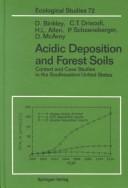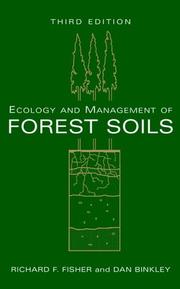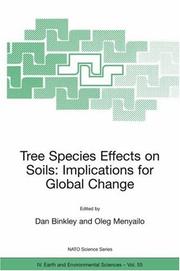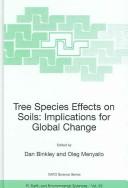| Listing 1 - 9 of 9 |
Sort by
|

ISBN: 038796889X 1461281679 1461235863 Year: 1989 Volume: vol 72 Publisher: New york London Paris Springer
Abstract | Keywords | Export | Availability | Bookmark
 Loading...
Loading...Choose an application
- Reference Manager
- EndNote
- RefWorks (Direct export to RefWorks)
Soil pollution. Soil purification --- USA: South --- USA: East --- 551.577.13 --- 631.415.2 --- 630*11 <75> --- Acid deposition --- -Forest soils --- -Soil acidity --- -Acidity of soils --- Hydrogen-ion concentration --- Acid soils --- Soils --- Acidic deposition --- Deposition, Acid --- Pollutants --- Acidity of precipitation, acid rain --- Acidity. Acid soils --- Site factors. Climate, situation, soil in forestry. Forest hydrology and meteorology--Verenigde Staten van Amerika: Zuid-Oostelijke staten --- Environmental aspects --- -551.577.13 --- -Acidity of precipitation, acid rain --- 630*11 <75> Site factors. Climate, situation, soil in forestry. Forest hydrology and meteorology--Verenigde Staten van Amerika: Zuid-Oostelijke staten --- 631.415.2 Acidity. Acid soils --- 551.577.13 Acidity of precipitation, acid rain --- -Soil pollution. Soil purification --- -631.415.2 Acidity. Acid soils --- Acidity of soils --- -Acid deposition --- Forest soils --- Soil acidity --- Southern States
Book
ISBN: 9781119703204 Year: 2021 Publisher: Hoboken, NJ : Wiley-Blackwell,
Abstract | Keywords | Export | Availability | Bookmark
 Loading...
Loading...Choose an application
- Reference Manager
- EndNote
- RefWorks (Direct export to RefWorks)
Forest ecology is the science that deals with everything in forests, including plants and animals (and their interactions), the features of the environment that affect plants and animals, and the interactions of humans and forests. All of these components of forests interact across scales of space and time. Some interactions are constrained, deterministic, and predictable; but most are indeterminant, contingent, and only broadly predictable.Forest Ecology: An Evidence-Based Approach examines the features common to all forests, and those unique cases that illustrate the importance of site-specific factors in determining the structure, function, and future of a forest. The author emphasizes the role of evidence in forest ecology, because appealing, simple stories often lead to misunderstandings about how forests work. A reliance on evidence is central to distinguishing between appealing stories and stories that actually fit real forests.The evidence-based approach emphasizes the importance of real-world, observable science in forests. Classical approaches to ecology in the twentieth century often over-emphasized appealing concepts that were not sufficiently based on real forests. The vast amount of information now available on forests allows a more complete coverage of forest ecology that relies on a strong, empirical foundation.
Digital
ISBN: 9781402034473 Year: 2005 Publisher: Dordrecht Springer
Abstract | Keywords | Export | Availability | Bookmark
 Loading...
Loading...Choose an application
- Reference Manager
- EndNote
- RefWorks (Direct export to RefWorks)
General ecology and biosociology --- Pedology --- Forestry --- bodemkunde --- bodembescherming --- bossen --- ecosystemen --- klimaatverandering

ISBN: 0471194263 9780471194262 Year: 2000 Publisher: New York (N.Y.): Wiley,
Abstract | Keywords | Export | Availability | Bookmark
 Loading...
Loading...Choose an application
- Reference Manager
- EndNote
- RefWorks (Direct export to RefWorks)
Forest soils. --- Soil ecology. --- Soil management. --- Forest management. --- Environmental Sciences and Forestry. Soil Science --- Soil Science (General) --- Soil Science (General).
Book
ISBN: 9780470979471 9780470979464 Year: 2012 Publisher: Hoboken, NJ : Wiley,
Abstract | Keywords | Export | Availability | Bookmark
 Loading...
Loading...Choose an application
- Reference Manager
- EndNote
- RefWorks (Direct export to RefWorks)
ecology --- Forest management --- Forest soils --- Soil biology --- forest ecology --- Sampling --- Forest litter --- Forest soils. --- Soil ecology. --- Soil management. --- Forest management. --- Soil ecology --- Soil management --- 630 --- Soils --- Soil science --- Agronomy --- Edaphology --- Ecology --- Roots (Botany) --- Forest administration --- Forest plants --- Forest resource administration --- Forest resource management --- Forest stewardship --- Forest vegetation management --- Forestry management --- Forests and forestry --- Stewardship, Forest --- Vegetation management, Forest --- Ecosystem management --- Natural resources --- 630 Forestry --- Forestry --- Management --- Environmental aspects --- Administration --- Control
Book
ISSN: 00708356 Year: 1992 Publisher: Berlin Springer-Verlag
Abstract | Keywords | Export | Availability | Bookmark
 Loading...
Loading...Choose an application
- Reference Manager
- EndNote
- RefWorks (Direct export to RefWorks)

ISBN: 9781402034459 9781402034473 Year: 2005 Publisher: Dordrecht Springer Netherlands
Abstract | Keywords | Export | Availability | Bookmark
 Loading...
Loading...Choose an application
- Reference Manager
- EndNote
- RefWorks (Direct export to RefWorks)
Almost 50% of the total area of Austria is forested, and the forests are dominated by commercially valuable stands of Norway spruce ( (Picea abies). The few remaining forests that resemble the natural vegetation composition are located in forest reserves with restricted management. These natural forests are used as reference systems for evaluating silvicultural research on sustainable forest management. Natural forests are expected to have high biodiversity, where the structural richness of the habitat enables complex relationships between fauna, flora, and microflora. They also provide refugia for rare plants and animals found only in natural forest types. Austria had 180 of these forest reserves up to the year 2003. Most of these forests are privately owned, and owners are compensated by the government for loss of income associated with conservation status. The Ministerial Conference for the Protection of Forest Ecosystems (MCPFE) has launched a world-wide network of protected forest areas which should cover all major forest types (MCPFE and UNECE/FAO, 2003). The sites selected for our investigation of soil conditions and communities were chosen by vegetation ecologists and soil scientists. The stands have developed under natural competition conditions with no management interventions. All sites were well documented with known forest history. Our set of sites spans gradients of environmental conditions as well as species composition, providing a realistic evaluation of the interactions of biotic and abiotic factors.
Book
ISBN: 354097895X Year: 1992 Publisher: New York London Paris Springer
Abstract | Keywords | Export | Availability | Bookmark
 Loading...
Loading...Choose an application
- Reference Manager
- EndNote
- RefWorks (Direct export to RefWorks)

ISBN: 1402034458 1402034474 9781402034466 1402034466 9781402034459 9786611335984 1281335983 Year: 2005 Volume: 55 Publisher: Dordrecht: Springer,
Abstract | Keywords | Export | Availability | Bookmark
 Loading...
Loading...Choose an application
- Reference Manager
- EndNote
- RefWorks (Direct export to RefWorks)
Almost 50% of the total area of Austria is forested, and the forests are dominated by commercially valuable stands of Norway spruce ( (Picea abies). The few remaining forests that resemble the natural vegetation composition are located in forest reserves with restricted management. These natural forests are used as reference systems for evaluating silvicultural research on sustainable forest management. Natural forests are expected to have high biodiversity, where the structural richness of the habitat enables complex relationships between fauna, flora, and microflora. They also provide refugia for rare plants and animals found only in natural forest types. Austria had 180 of these forest reserves up to the year 2003. Most of these forests are privately owned, and owners are compensated by the government for loss of income associated with conservation status. The Ministerial Conference for the Protection of Forest Ecosystems (MCPFE) has launched a world-wide network of protected forest areas which should cover all major forest types (MCPFE and UNECE/FAO, 2003). The sites selected for our investigation of soil conditions and communities were chosen by vegetation ecologists and soil scientists. The stands have developed under natural competition conditions with no management interventions. All sites were well documented with known forest history. Our set of sites spans gradients of environmental conditions as well as species composition, providing a realistic evaluation of the interactions of biotic and abiotic factors.
Biogeochemistry. --- Forest soils. --- Forest ecology. --- Trees. --- Afforestation --- Biogéochimie --- Sols forestiers --- Ecologie forestière --- Arbres --- Boisement --- Biogeochemistry --- Forest soils --- Forest ecology --- Trees --- Ecology --- Biology - General --- Earth & Environmental Sciences --- Biology --- Health & Biological Sciences --- Biogéochimie --- Ecologie forestière --- EPUB-LIV-FT LIVBIOLO SPRINGER-B --- Forest planting --- Forestation --- Dendrology --- Forests and forestry --- Life sciences. --- Ecosystems. --- Forestry. --- Soil science. --- Soil conservation. --- Life Sciences. --- Soil Science & Conservation. --- Nursery stock --- Woody plants --- Arboriculture --- Timber --- Soils --- Biochemistry --- Geochemistry --- Hurricane protection --- Natural resources --- Reforestation --- Tree planting --- Endangered ecosystems. --- Forests and forestry. --- Conservation of soil --- Erosion control, Soil --- Soil erosion --- Soil erosion control --- Agricultural conservation --- Soil management --- Forest land --- Forest lands --- Forest production --- Forest sciences --- Forested lands --- Forestland --- Forestlands --- Forestry --- Forestry industry --- Forestry sciences --- Land, Forest --- Lands, Forest --- Silviculture --- Sylviculture --- Woodlands --- Woods (Forests) --- Agriculture --- Logging --- Tree crops --- Threatened ecosystems --- Biotic communities --- Nature conservation --- Control --- Prevention --- Conservation --- Pedology (Soil science) --- Earth sciences --- Biocenoses --- Biocoenoses --- Biogeoecology --- Biological communities --- Biomes --- Biotic community ecology --- Communities, Biotic --- Community ecology, Biotic --- Ecological communities --- Ecosystems --- Natural communities --- Population biology --- Afforestation - Russia - Siberia
| Listing 1 - 9 of 9 |
Sort by
|

 Search
Search Feedback
Feedback About UniCat
About UniCat  Help
Help News
News